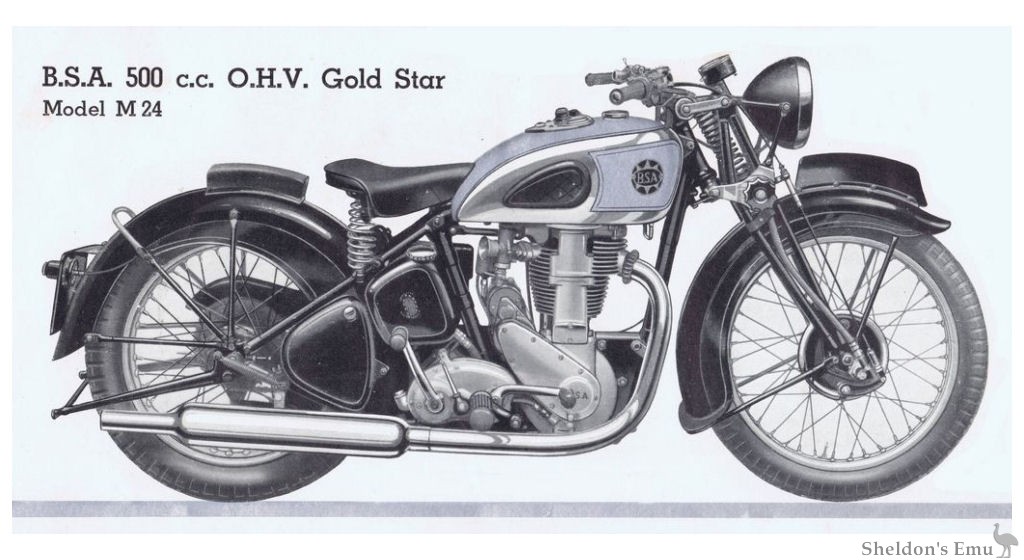


Built from 1938 to 1963 with 350cc and 500cc single-cylinder engines.
The BSA Gold Star is a 350cc and 500cc 4-stroke production motorcycle which gained a reputation for being one of the fastest machines of the 1950s and were very popular due to their high performance. Besides being hand built, with many optional performance modifications available, they came from the factory with documented dynamometer test results.
In 1937, Wal Handley lapped Brooklands at over 100 mph on a BSA Empire Star, and was awarded one of the traditional Gold Star pins for the feat. That inspired BSA to produce the BSA Gold Star model.
1938 M24. The first Gold Star was an M24. It had a 496 cc all-alloy engine, an Electron alloy gearbox, and a light steel tubular frame devoid of side-car lugs. This model continued until the onset of WWII.
1948 YB32. After the war the all-alloy 348 cc B32 Gold Star was released, with a very large list of optional components. When an order was placed the machine was assembled by hand, and the motor bench-tested. They were 20 lb lighter than the comparable cast iron barrel and head B-series singles and were very successful in the 350 class from 1949 to 1956. They could be specified in touring, trials, ISDT, scrambles, racing or Clubmans trim.
1948 engine numbers were prefixed YB, and '49 were ZB.
1949 ZB34. The 499 cc B34 Gold Star had a modified crankshaft and a different design main bearing. The 350 continued. In 1950 both models received larger front brakes.
In 1952 the 500 received a new Bert Hopwood designed cylinder head, and the 350 had a new head of that design the following year.
1953 BB34 and BB32. In 1953 a swing-arm duplex frame was introduced, along with an improved gearbox.
1954 CB34 and CB32. An optional CB motor was given more and squarer finning, stronger crank, a shorter conrod, oval flywheels (500), improved valve gear, and an Amal GP carb.
1955 DB34. The DB Gold Star had an improved oil feed to the crankshaft, and finned front brakes. If the buyer specified Clubman cams and timing, he also received a special silencer. At the end of this year the BB and CB models were discontinued.
1956 DBD34. The most prized model was the 500 cc DBD34 introduced in 1956, with clip-on handlebars, finned alloy engine, polished tank, 36 mm bell-mouth Amal carburettor and swept-back exhaust. The DBD34 had a 110 mph top speed. The Gold Star dominated the Isle of Man Clubmans TT that year. Later models had a very high first Gear, enabling 60 mph plus before changing up to second.
1963 End of production. Towards the end the Gold Star was only offered in scrambles or Clubmans trim. In 1963 Lucas ceased to produce the magneto used in the B series, and that line of singles was ended. A sporting single was not produced again till the BSA B50 models that were produced from 1971 through 1973. Some remaindered stock were marketed in 1974 as Triumphs, and later CCM used BSA B50 bottom ends in their early specials.
Source: Graces Guide